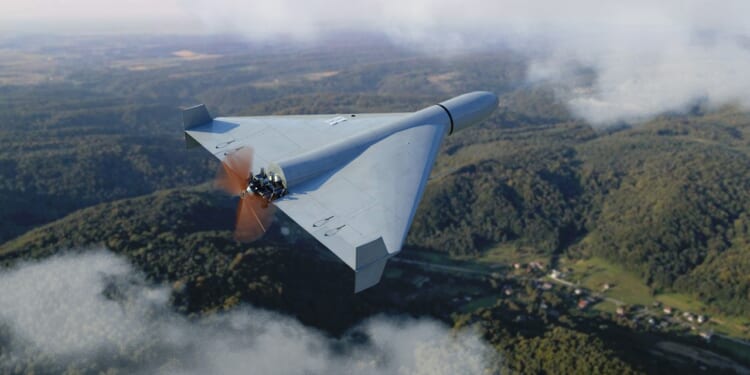The ASN-301 anti-radar drone will not be a silver bullet for China. But it will force Taiwan to take great precautions at a low cost to Beijing.
The ASN-301 is a Chinese loitering munition—a so-called “kamikaze” drone—optimized for anti-radiation Suppression of Enemy Air Defenses (SEAD) and/or Destruction of Enemy Air Defenses (DEAD) missions. An ASN-301 is designed to patrol an area, detect active radar emissions, and then the weapon homes in and crashes into the radar to destroy or suppress enemy air-defense sites.
This system appears to have been inspired by Israel’s Harpy and Iran’s Shahed-style delta-wing loitering munitions that have become ubiquitous both in the ongoing Middle East conflicts as well as the Ukraine War.
The ASN-301 Drone’s Specifications
- Year Introduced: Unknown (likely 2025)
- Number Built: Unknown
- Length: 2.5 m (8.2 ft)
- Wingspan: 2.2 m (7.2 ft)
- Weight: 135 kg (297 lb)
- Engines: Pusher propeller configuration
- Top Speed: 220 km/h (137 mph)
- Range: 288 km (180 mi) / 4 hours’ endurance
- Service Ceiling: Unknown
- Loadout: 66.1-88.2 lb warhead
- Aircrew: 0 (drone)
This Chinese-made delta-wing pusher-prop configuration possesses an onboard anti-radiation seeker tuned across broad radar bands, enabling the drone to destroy active radar emitters.
Global Security assesses that its warhead has a proximity/laser-fused detonation with thousands of fragments.
For the ASN-301’s launching mechanism, as noted it can be launched from either a truck-mounted canister launcher or from a warship. Recent footage propagated across social media suggests multiple ASN-301s can be launched at once from a single truck, meaning the swarming capabilities are highly lethal on this system.
The Functions of the ASN-301 Drone
The ASN-301’s lethality comes down to its ability to seek out and destroy enemy radar systems that are critical for things like air defense.
By removing the specific radar capability of a rival’s air defense network, the Chinese military can render that air defense system combat-ineffective because the ASN-301 would literally blind the sensors for that AD system, giving the Chinese military ample time to either evade destruction or to damage and/or destroy an enemy target that was protected by that AD network.
While the ASN-301 is an impressive—and cheap—system that can do significant amounts of damage to advanced, expensive AD systems, the fact remains that it is hardly a foolproof system. Indeed, anti-radiation weapons are not a new kind of weapon. So, an adversary being targeted by the ASN-301 could simply shut down their radars or employ decoys to keep the ASN-301 from targeting AD systems. What’s more, an adversary could simply move their radars to avoid having those radars locked onto by the ASN-301.
Lastly, an adversary could conceivably jam the ASN-301. Electronic warfare (EW) is a key element of modern warfare, after all. Passive radar architectures could further reduce an adversary’s vulnerability to the ASN-301, too.
Still, this system is not to be shrugged off. It widens China’s toolbox for counter-anti-access/area-denial (A2/AD) operations by suppressing American, Taiwanese, or other allied radars in a Taiwan Strait scenario, for example. Mobile launchers and endurance of the weapon increase reach beyond China’s coastlines. Its presence on an Indo-Pacific battlefield forces regional actors to rethink their own radar employment, hardening, and passive detection. It might even prompt US-allied actors to change their command-and-control techniques—or invest in costly, complex layered countermeasures. All of this is time-consuming and expensive.
The ASN-301 is but one of many examples of how China is fully developing their capacity to stymie Western defenses while preparing to lay the groundwork for their own forces to reclaim Taiwan (or any other Western-defended target in the Indo-Pacific, for that matter).
About the Author: Brandon J. Weichert
Brandon J. Weichert is a senior national security editor at The National Interest. Recently, Weichert became the host of The National Security Hour on America Outloud News and iHeartRadio, where he discusses national security policy every Wednesday at 8pm Eastern. He is also a contributor at Popular Mechanics and has consulted regularly with various government institutions and private organizations on geopolitical issues. Weichert’s writings have appeared in multiple publications, including The Washington Times, National Review, The American Spectator, MSN, The Asia Times, and others. His books include Winning Space: How America Remains a Superpower, Biohacked: China’s Race to Control Life, and The Shadow War: Iran’s Quest for Supremacy. His newest book, A Disaster of Our Own Making: How the West Lost Ukraine is available for purchase wherever books are sold. He can be followed via Twitter @WeTheBrandon.
Image: Shutterstock / Anelo.

















